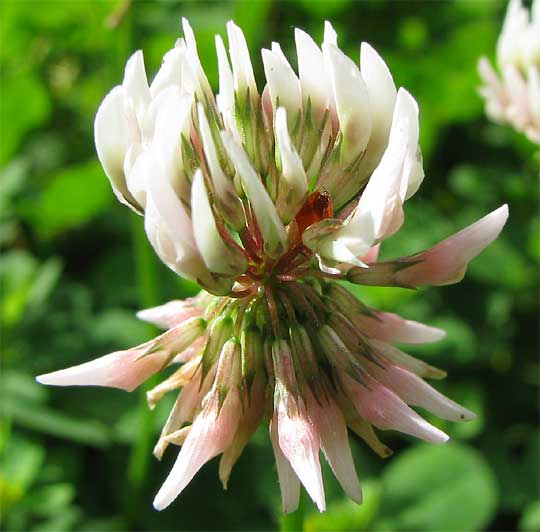Excerpts from Jim Conrad's
Naturalist Newsletter

from the the March 30, 2009 Newsletter, issued from the forest near Natchez, Mississippi; elevation ~400ft (120m), ~N31.47°, ~W91.29°:
WHITE CLOVER
Along roads, in pastures and in people's yards, White Clover, TRIFOLIUM REPENS, produces homey-feeling, diffuse, white smudges in green grass, as shown above.
Of course the little white balls are clusters or heads of flowers, a close-up of a single head being shown below:

In that picture notice how the upper flowers bend upward and are pure white while lower flowers nod downward and are turning pinkish. This is to help pollinators. The upper, brighter and therefore more conspicuous blossoms need pollination while the drooping flowers, their red hue looking dark in the bees' infrared-seeing eyes, are less noticeable.
Clovers are members of the big Bean Family and clover flowers are "papilionaceous" like the flowers of most Bean Family members. By "papilionaceous" is meant that they are "butterfly-like," the five petals configured in a special way, usually with the flaring "standard" held above, two "wings" on each side, and the two lower petals joined along their common margins into a scoop-like "keel." There's more about papilionaceous flowers at http://www.backyardnature.net/fl_beans.htm.
There are lots of clover species -- about 300 in the genus Trifolium. Several, such as the Buffalo-Clovers, are native American, but most clovers seen in pastures and along roads have been introduced from Eurasia. To be sure you have a White Clover and not a look-alike species, such as the white-flowered Alsike Clover, notice that White Clover's flower heads arise on long stems, or peduncles, attached to stems creeping closely atop the ground, instead of rising vertically or just leaning onto other vegetation. Also the calyx's sepals are shorter than the calyx tube below the sepals, as you can see in the head picture.
This is one invasive species, originally from Eurasia and northern Africa, that I'm glad made it to the Americas. Everyone knows how grazing animals thrive eating it, how it supplies honeybees with copious nectar, and how its roots, equipped with mycorrhiza-bearing nodules, fix nitrogen, thus enriching the soil and contributing fertilizer to surrounding organisms. White Clover is good citizen, though it's been known to out-compete rarer plants, especially in fertile soils.